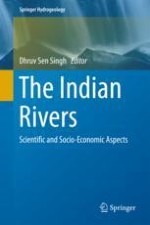Abstract
Damodar River basin has a total catchment area of 25,820 km2 and is a part of the Ganges River System. Drainage area of Damodar basin extends from 22° 45′N–24° 30′N and 84° 45′E to 88° 00′E and is covering about 11.8% of the total geographical areas of Jharkhand and 8.6% of West Bengal states. Catchment area of Damodar River basin extends over Hazaribagh, Ramgarh, Koderma, Giridih, Dhanbad, Bokaro, and Chatra districts in Jharkhand and Burdwan and Hooghly districts in West Bengal. It partially covers Palamau, Ranchi, Lohardaga, and Dumka districts in Jharkhand and Howrah, Bankura, and Purulia districts in West Bengal. It is a small rain-fed river originating from Khamarpat hill at the trijunction of Palamu, Ranchi, and Hazaribag districts of Jharkhand and travels about 541 km distance before joining the lower Ganga (Hooghly estuary) at Shayampur, 55 km downstream of Howrah. Damodar River flows through the industrial towns of Ramgarh, Bokaro, Dhanbad, Asansol, Durgapur, Burdwan, and Howrah. It has varying landforms such as plateaus, hills, uplands, and flat plains. Geology of the basin is characterized by the rocks consisting of granites and granitic gneisses of Archaeans, sandstones and shales of the Gondwanas and the recent alluvial. Damodar basin is known for its coal deposits, accounting for 46% of the country’s coal reserves and commonly referred as the ‘store house of Indian coal.’ Several other minerals are also associated with the geological formations of the river basin such as mica, fireclay, bauxite, limestone, china clay, baryte, ironstone. Coal washeries, coal mining, mining dumps, cock industries, thermal power plants, mining machineries, and vehicular emission are the major sources of the pollutants in the Damodar River basin. The water and sediment quality of the river basin are severely affected by the pollutants released from these point and nonpoint sources of pollution. Less than 20% of the Damodar basin area is under vegetation cover and a light savanna type of woodland with secondary growth of shrubs and vines form the major vegetation types. Damodar Valley Corporation (DVC) is a major responsible agency for water supply through dams, canals and barrage for irrigation, industrial and domestic purposes. Damodar Valley Corporation (DVC) proficient management of water resources has turned the devastating river Damodar from a ‘River of Sorrow’ to a ‘River of Opportunities.’
